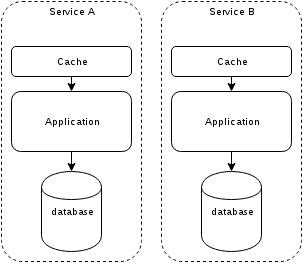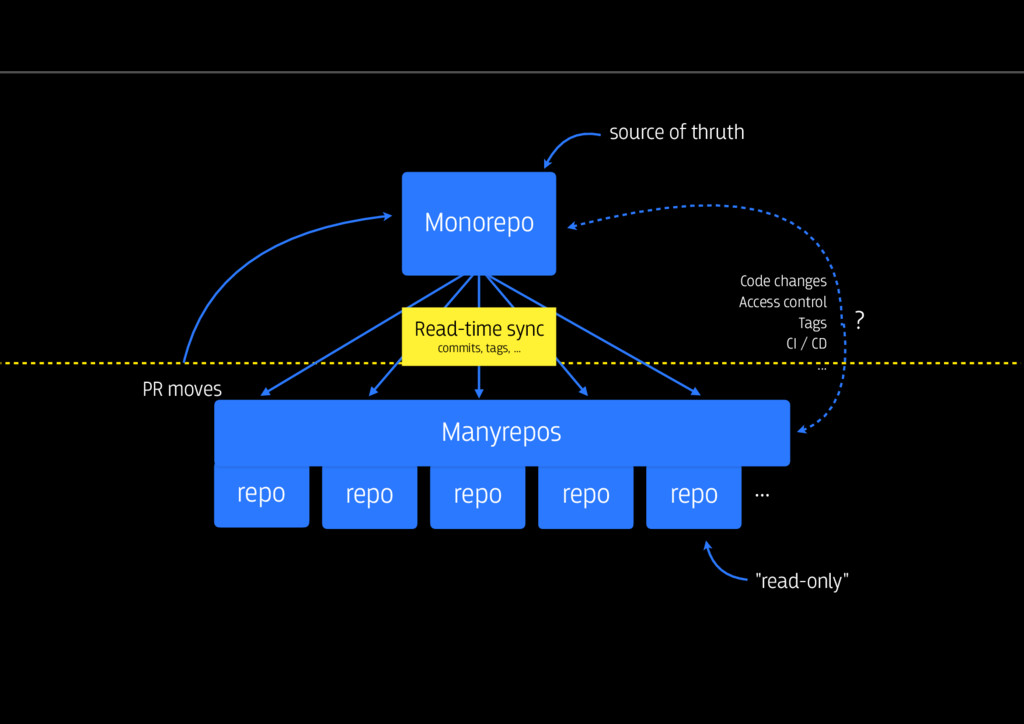FMM
Overall schema

Database usages
Write
- 10% of traffic
- simple requests
- ACID
- 100% BO
Read
- 90% of traffic
- complex joins
- high availability
- 100% FO
CQRS
Command Query Responsibility Segregation

How to?
- Using RabbitMq to Async commands
- Scalable
- Fault tolerance
- Storing Domain Model in PgSQL
- consistency
- Storing Read Model data in ES
- fast
- fulltext search
- cross brand queries
Drawback
- Data are dupplicated
- increase storage size
- possible inconsistency
- Update an sub-entity => recompute several entities
- Decrease resilience
Benchmark
Base on a ~19Ko article and 5 Joins
| With PgSQL | With ES
--------------+-------------+---------------
1000 articles | 22 secondes | 0,675 seconde
Recommandations
- Use RabbitMQ to handle async requests
- Use PgSQL to store relationnal data
- Store a Ready to fetch view in ElasticSearch
Multi brand
- Isolate environments
- Security
- Performances
- Backup time
- Allow different application's version
Segmented services
- 1 database per brand
- 1 application-server per brand
- Physically separated on several hosts
Keep the brand in data
- Specify the brand in queries and responses
- Allow "shared" service to store several brands
Unique Identifier
- Use uuid v1 to identify resources
- Unique in space (based on server's mac adresse)
- Unique in time (based on server's time)
- Allow several brands to be merged in the future
Drawback
- Increase hosting cost
- Add complexity to expose "cross-brand" API
Go further: Docker
- Isolate environments
- Improve deployments with "ready to use" images
- Hybride infrastructure
- VM (or BareMetal) to host databases
- Docker to host applications
| VM | Docker
-------------+---------+---------
Boot time | ~1 min | 0.3 sec
Memory usage | ~256 Mo | 1 Mo
Disk usage | ~1 Go | 100 KoRecommandations
- Split environments by brand
- Keep a field "brand" in queries and storage
- Use docker to easily scale applications
Authentication
needs
- Restrict access to services
- Restrict access by client
- Simple (no ACL, ...)
JWT
eyJhbGciOiJIUzI1NiIsInR5cCI6IkpXVCJ9.eyJyb2xlcyI6WyJyZWFkIiwid3JpdGUiXX0.sScm9scsYDYNASEmwkwCCNm3F5i9Qq6BNdeF2mN-rL0
{
"alg": "HS256",
"typ": "JWT"
}
{
"roles": ["read", "write"]
}
HMACSHA256( base64UrlEncode(header) + "." + base64UrlEncode(payload), "secret" )
Recommendation
- Use JWT to store "roles" per client
- Add a service "authentication"
- Use the nginx Gateway to
- decode JWT
- validate JWT
- restrict acces by route
JWT Workflow
Recommandations
- Use JWT to authenticate clients
- Add an "Authentication" service to create the token
- Validate security at the gateway level
HTTP Cache
managed at service level

HTTP Cache
avantages
- autonomous services
- no dependencies between services
- services able to warmup cache
- services able to invalidate cache
Caching strategy
always up to date
- Use long life cache
- Cache invalidation managed by application
- With Nginx: Purge resource's URIs
- With Varnish: Use Tags
HTTP Cache
benchmark based on an standard API request
| Without cache | With cache
--------------+---------------+------------
100 requests | 0m17.162s | 0m0.252s
1000 requests | 2m45.451s | 0m1.160s
- HTTP call < 2ms
- Don't use cache at client's level
- Expose small cachable resources
FMM's Unified cache
- Keep cache on top of fronts
- Add a service to purges those caches
- When a services update a "resource" it trigger an invalidation to the cache
- How to convert "resource" to URL ?
- Convert API's unified cache into "Converter"'s cache
- Same as front's cache
- How to convert "resource" to URL ?
Recommandations
- Use only HTTP cache
- Each service manage his own cache
- Use cache invalidation instead of expirity
- Add a "cache" service in charge of invalidating FO caches
Several API format
- Each client has a different need
- Mobile needs light responses
- Site's Homepage needs basics informations
- Site's article needs a full response
GraphQL
- by Facebook
- Query language specifications
- Alternative to REST
GraphQL
{
user(id: 3500401) {
id,
name,
isViewerFriend,
profilePicture(size: 50) {
uri,
width,
height
}
}
}Request
{
"user" : {
"id": 3500401,
"name": "Jing Chen",
"isViewerFriend": true,
"profilePicture": {
"uri": "http://someurl.cdn/pic.jpg",
"width": 50,
"height": 50
}
}
}Response
Usage
- Handled by the "conversion" service
- Replacement for json, json2, json_mobile
- Less cachable : new request = new cache
Recommandations
- If there are many different formats
- Use GraphQL to fetch articles
- Use GraphQL to fetch articles
- https://github.com/overblog/GraphQLBundle
- https://github.com/webonyx/graphql-php
Development environment
- Reduce Time to market
- Improve quality
- Implemented with the coach
Automatize dev stack
- Ansible (or docker) to build dev environment
- Closest to the production environment
- Fast and easy bootstrap
CI
- Automatized builds with Gitlab CI (or Jenkins)
- phpmetric to monitor the code quality
- Sensiolabs Insight to analyse the code
- Blackfire to spot performance issues
Monolithic repository
- 1 repository
- 1 sub repository per application
- Automaticaly generated from main repo
- Isolated deployment

Recommandations
- Industrialized dev environment
- Monitor tests and quality with the CI
- Use monolithic repository
Questions ?
deck
By Jérémy DERUSSÉ
deck
- 1,585



